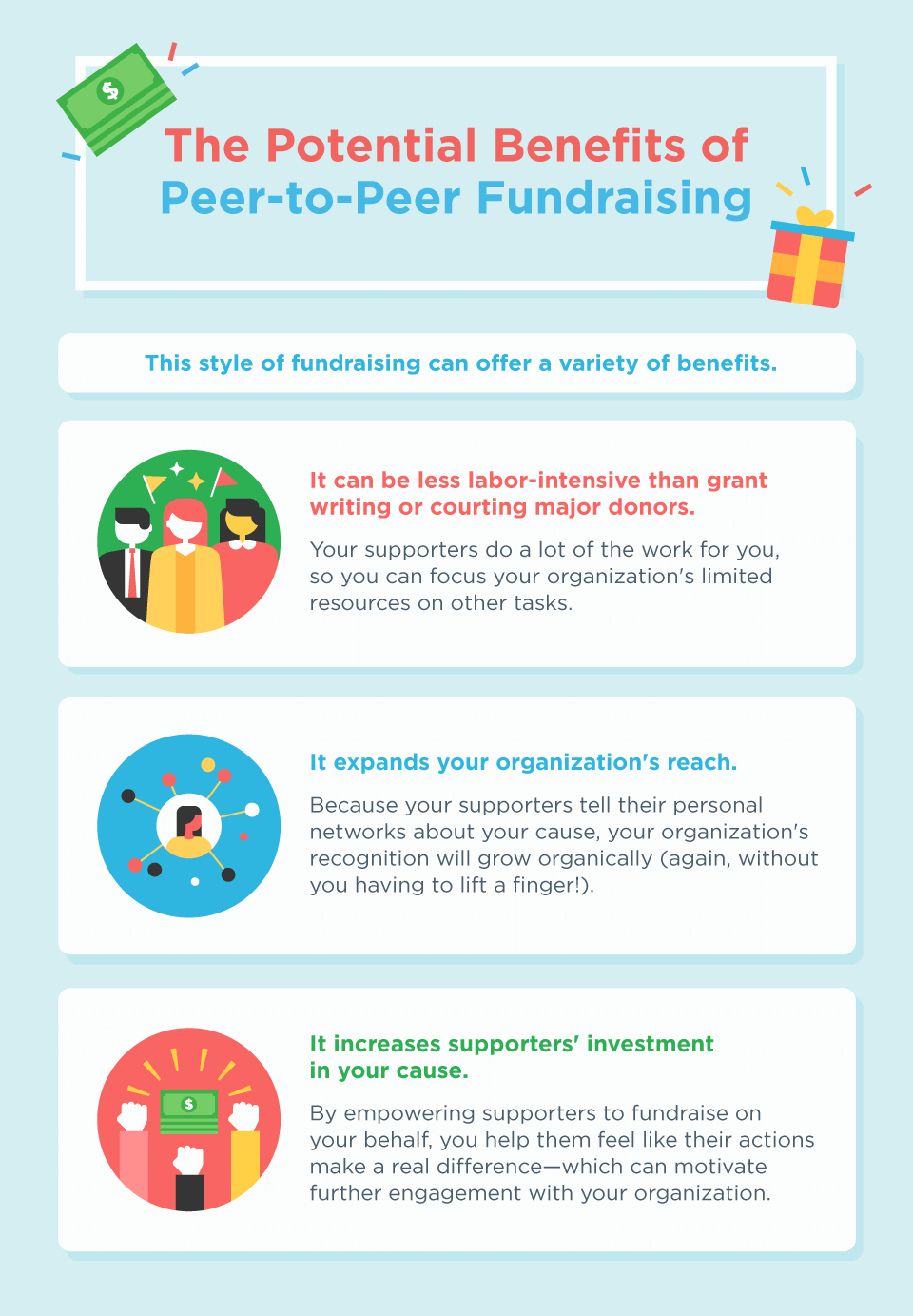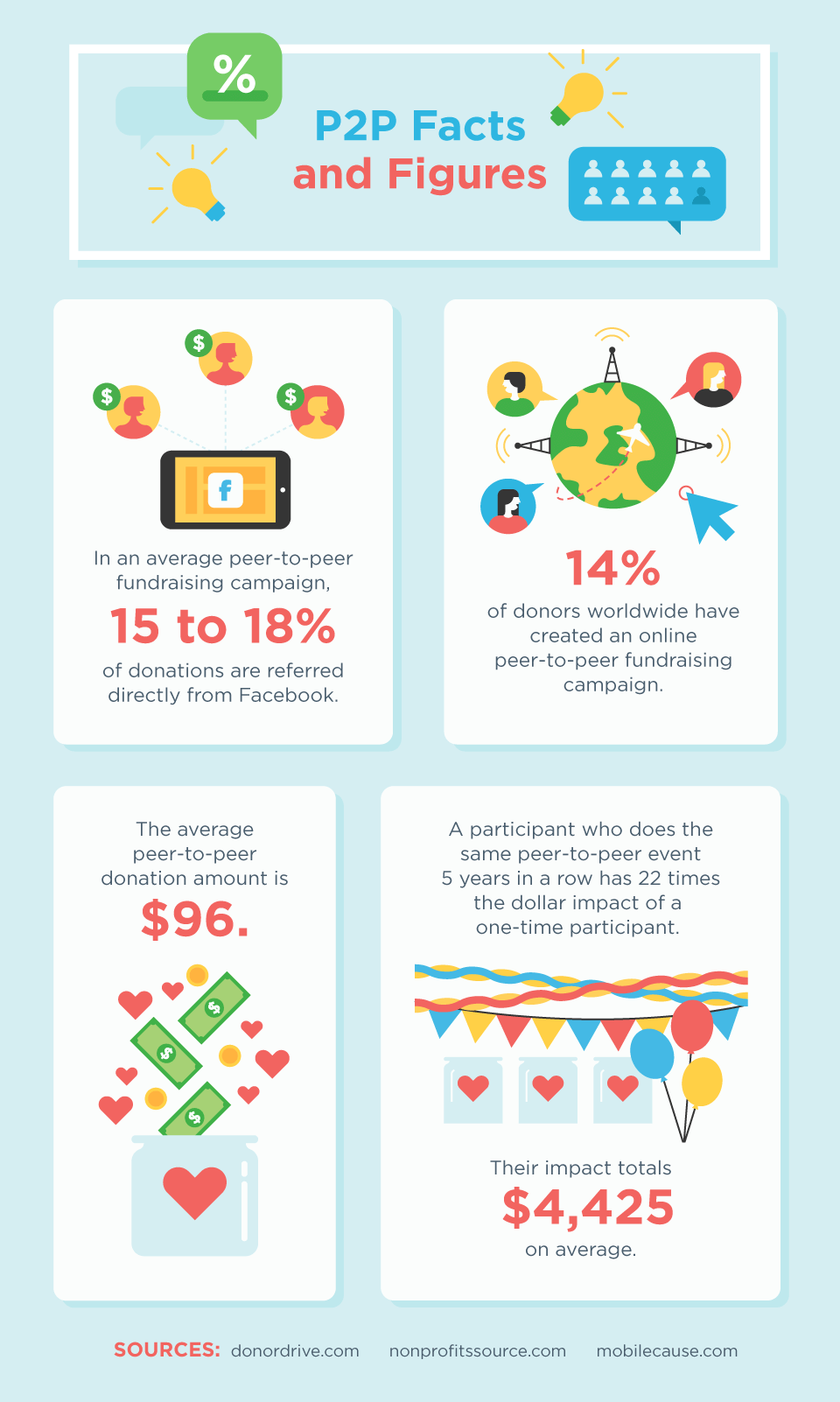Article by Laura Newcomer
The term “peer-to-peer fundraising” might conjure images of begging your friends to pony up for your car payment or your cat’s medical bills. But that’s not actually what we’re talking about here.
(Though by all means, do whatever it takes to help your cat!)
If you’re wondering how to fundraise for a personal cause, this article might not be exactly what you’re after.
But if you’re part of an organization that’s looking to enhance its fundraising while expanding its recognition, or you’re looking to fundraise on behalf of an organization that’s near and dear to your heart, then you’ve come to the right place.
That’s because peer-to-peer fundraising is a great way to raise funds for many types of causes and organizations.
In fact, research from The Peer-to-Peer Fundraising Thirty suggests the top 30 peer-to-peer fundraising campaigns in the U.S. raised more than $1 billion in 2017 alone.
Want to claim a piece of that pie?
Read on to learn what peer-to-peer fundraising is all about, plus how to get started with your own campaign.

What Is Peer-to-Peer Fundraising?
What we’re talking about here is a particular style of fundraising that involves empowering your organization’s campaigners to raise funds for your organization by encouraging the people in their network—family, friends, colleagues, and so on—to donate to the cause.
You might also hear peer-to-peer fundraising referred to as P2P fundraising, personal fundraising, social fundraising, or team fundraising.
There are lots of ways to do a P2P fundraising campaign—many of which you’ve probably participated in yourself.
For example, there are time-limited P2P campaigns where fundraisers might challenge their communities to help them raise a specific dollar amount within a specific amount of time (such as #GivingTuesday).
Other examples include activities like walkathons, fundraising events, or personal challenges like No-Shave November where people skip shaving for a month and raise funds from their networks to support cancer prevention and research.

How Does Peer-to-Peer Fundraising Work?
Just like snowflakes, each P2P campaign is unique. Here’s a basic overview of how the process works
- The nonprofit identifies its fundraising goal and decides which style of P2P campaign they’d like to run: time-based, rolling, or a giving day.
- Time-based campaigns take place over a specific time period and often correspond with a kick-off or concluding event.
- Rolling campaigns continue for as long as it takes to meet a particular goal.
- Giving days designate a financial goal and aim to meet it within 24 hours.
- The nonprofit chooses a fundraising platform that’s best suited to its campaign.
- The nonprofit recruits campaigners, who commit to setting up personal campaign pages, soliciting donations from their networks, and marketing the campaign.
- During the campaign, the nonprofit supports its fundraisers with resources, promotion, and appreciation. The nonprofit also keeps tabs on their fundraisers’ progress, and follows up with new donors.
- Depending on the style of P2P campaign, the campaign concludes after a financial goal is reached or a deadline passes.
What is the Difference Between Peer-to-Peer Fundraising and Crowdfunding?
It’s easy to confuse peer-to-peer fundraising with crowdfunding because both strategies involve tapping into a large network of donors to solicit many smaller donations. In fact, P2P fundraising is often considered a type of crowdfunding.
But it also differs from crowdfunding in several ways
- Crowdfunding campaigns are managed by the organization that’s doing the fundraising, whereas peer-to-peer fundraising will involve many “managers” (i.e. campaigners) working to drum up donations. Think of crowdfunding as a one-to-many approach, whereas P2P is many-to-one. Crowdfunding campaigns are managed by 1 person: the person doing the fundraising. These campaigns involve tapping into the organizer (or organizer’s) network for donations and hoping the word will spread. P2P campaigns have word-of-mouth marketing baked into them, because your campaigners are charged with doing just that.
- Crowdfunding campaigns often have a specific fundraising goal in mind and use a single progress bar to track overall progress. In contrast, P2P fundraising might involve many mini goals that are specific to the campaigners involved (though this often depends on the type of P2P fundraiser).
- Crowdfunding campaigns typically rely on a single web page, whereas P2P fundraising will probably involve many personalized web pages managed by individual campaigners.

5 Best Practices for Peer-to-Peer Fundraising
Every peer-to-peer fundraising campaign is different, which means the strategies that work well for one organization might fall as flat as an under-baked cake for another.
That said, here are a few general best practices that should apply to nearly every P2P fundraising effort.
1. Make sure your web pages are easy to navigate
Because your campaigners will most likely use a personal web page to solicit and track donations, they need to be able to navigate the site without much hassle. Learn more about how to create a personal fundraising page here.
2. Make your web pages look pretty
No matter the fundraising campaign, good design is important. People will be more likely to stick around on the site, get inspired, and donate if the pages are thoughtfully organized, mobile-optimized, and nice to look at. (We’re willing to bet that white font on a black background has never inspired a major donation!)
Wondering which personal fundraising website you should use? Check out this list of 10 stellar options.
3. Promote the campaign
While it’s tremendously helpful when your campaigners raise funds for your organization, it (unfortunately) doesn’t mean you can spend the campaign sipping mimosas at a spa.
Make sure to promote the campaign on your organization’s website, social media platforms, and perhaps via direct mail to boost the reach of your hardworking P2P campaigners.
4. Follow up with new donors
As soon as new donors contribute, thank them and add them to your donor database. That way, when a new P2P campaign rolls around, your pool of potential campaigners will be even larger!
5. Show appreciation for your campaigners
Peer-to-peer fundraising campaigns only happen because people who believe in your cause are willing to volunteer their time to help raise funds. That’s a huge honor, and it’s important that your organization acts like it by profusely thanking—even gifting—your generous campaigners.

6 Tips for Starting a Peer-to-Peer Campaign
Okay, you’re convinced peer-to-peer fundraising might work for your organization. So how do you actually create a personal fundraiser?
Fear not! We’ve got some tried-and-true tips to start your own peer-to-peer campaign.
1. Choose your campaign type
Before launching a P2P campaign, take time to consider which format best suits your goals. Most P2P campaigns fall into one of the following categories: time-based campaigns, rolling campaigns, and giving days. The right choice for you will depend on your financial goals, time constraints, staff capabilities, and intentions regarding how the money will be used.
2. Select your fundraising software
There are dozens of fundraising platforms available, which means nonprofits have more choices than ever before. The right platform will be the one that’s best tailored to your organization’s specific needs, but here are a few features to look for.
- The option to create individual fundraising pages
- The option to customize giving forms
- The option to easily share the campaign on social media
- Ease of use
- Integration with merchandise sales
- Gamification options (such as badges, progress bars, leaderboards, etc.)
- Technical support
3. Craft your story
Both campaigners and donors are more likely to stay involved in your campaign if it’s driven by a compelling story. Before you start recruiting participants, take time to think about the story that explains why people should care about your campaign. (Hint: “Because our roof is caving in” is not a compelling story. But “Ginny’s life got better in this home, and now we’re trying to build a new roof so we can improve other kids’ lives too” just might.)
When you start working with campaigners, educate them about the power of story. Their appeals to their networks will be much more effective if they tell the story of why they have personally come to support your cause instead of simply saying, “I’m raising money. Click here to donate.” (Not very motivating, right?)
4. Identify your campaigners
Browse through your donor database to identify people who have demonstrated high levels of enthusiasm for your cause by volunteering their time, making regular or large donations, and/or expressing interest in doing more. These are indicators that a person will be motivated to advocate on your behalf.
It might also be helpful to identify opportunities for partnerships with local businesses, other nonprofits, influencers, and/or major donors. Some of these partners might be willing to offer matching gifts, which can be a great way to boost participation in your campaign.
5. Set your campaigners up for success
Once you gather your crew of peer-to-peer fundraisers, give them the resources necessary to fundraise successfully. That might include:
- An on-boarding session that introduces participants to the campaign’s structure, story, and goals
- Regular check-ins (in person or via digital conferencing)
- Tutorials for navigating their personal fundraising page
- Email and social media templates
- Sharing participants’ posts on social media
- Regularly celebrating your fundraisers
6. Follow up
At the end of the campaign, make sure to update everyone who participated and thank your campaigners and new donors.
Then, plan to stay in touch with all your campaigners (old and new) as you put their money to good use. Showing people they’ve contributed to something meaningful will inspire them to get involved next time another campaign rolls around.
Stellar Examples of Peer-to-Peer Fundraising
Struggling to come up with ideas for your peer-to-peer fundraiser? Here are a few tried-and-true options to get your creative wheels turning.
- Athletic events such as runs, walks, swims, and golf outings where campaigners raise funds from their network prior to participating in the event
- Bowl-a-thons, game nights, rubber ducky races, and other family-friendly competitions
- Pub crawls or casino nights (if you’re going the less family-friendly route!)
- Quirky challenges, such as No Shave November or polar plunges
It might also be helpful to get your campaigners involved in choosing the theme and format of the campaign. They could come up with something that’s never been done before, which is sure to attract attention. For instance, one participant in the Children’s Miracle Network’s Extra Life campaign committed to getting a tattoo if his friends and family raised $2,000!
Conclusion
Peer-to-peer fundraising is kind of like a great big family reunion: It offers your organization the chance to connect with a sprawling network of people you might never have previously talked to. Only in this case, odds are good that those people will be interested in supporting your organization’s cause (instead of fighting over politics by the punch bowl).
By empowering your campaigners to raise funds on your organization’s behalf, you’ll grow your nonprofit’s pool of campaigners, raise money, and build relationships with people who will continue to cheerlead your organization even after the campaign has ended.
Share this Infographic On Your Site


